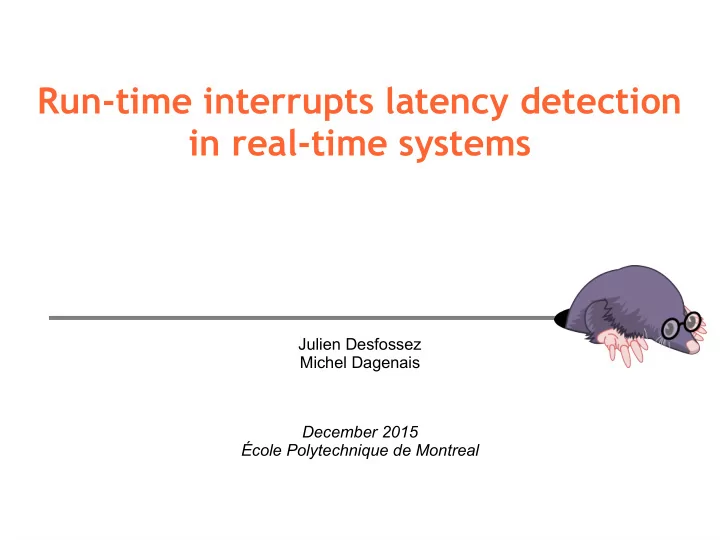

Run-time interrupts latency detection in real-time systems Julien Desfossez Michel Dagenais December 2015 École Polytechnique de Montreal
Latency-tracker ● Kernel module to track down latency problems at run-time ● Simple API that can be called from anywhere in the kernel (tracepoints, kprobes, netfilter hooks, hardcoded in other module or the kernel tree source code) ● Keep track of entry/exit events and calls a callback if the delay between the two events is higher than a threshold 2
Usage tracker = latency_tracker_create(threshold, timeout, callback); latency_tracker_event_in(tracker, key); .... latency_tracker_event_out(tracker, key); If the delay between the event_in and event_out for the same key is higher than “threshold”, the callback function is called. The timeout parameter allows to launch the callback if the event_out takes too long to arrive (off-CPU profiling). 3
Implemented use-cases ● Block layer latency – Delay between block request issue and complete ● Wake-up latency – Delay between sched_wakeup and sched_switch ● Network latency ● IRQ handler latency ● System call latency – Delay between the entry and exit of a system call ● Offcpu latency – How long a process has been scheduled out 4
Performance optimizations ● Controlled memory allocation ● Lock-less per-cpu RCU free-list ● Out-of-context reallocation of memory if needed/enabled ● Kernel-ported lock-less userspace-rcu hashtable ● Custom call_rcu thread to avoid the variable side-effects of the built-in one 5
Tracking interrupts latency ● Start tracking when the kernel receives the interrupt ● Compute the delay up to the moment when: – The target task get scheduled in – The target task informs the kernel it finished its work – The target task goes back to waiting for the next interrupt ● Launch a user-defined action on high latency 6
Tracking interrupts latency ● Work with the two main workloads: – periodic (timers) – aperiodic (hardware interrupts) 7
Interrupts critical path in the mainline kernel 8
Interrupts critical path in the PREEMPT_RT kernel 9
Tracking state evolution ● The relevant information is known while processing the chain ● Not a single matching entry/exit key ● Need to make the state changes in real-time ● Filter based on the target use-case: – IRQ number – SoftIRQ number – Target PID/Procname – Only real-time priority tasks 10
Online critical tree ● Tracking an interrupt up to the point where a user-space task starts to run is usually a chain (no branches) ● But if we track an interrupt until the target task completes its work, there can be a lot of branches ● Each call to sched_waking or softirq_raise creates a new branch in the chain 11
Online critical tree ● We stop the tracking when one chain matches all the criteria ● We only know which one at the end ● So we need to track everything and cleanup as soon as possible to limit the overhead 12
Demos ● User inputs ● Jack realtime sound server 13
Overhead ● Early measurements ● 740ns per state change for keeping the state ● 6 state changes --> 4.4µs ● Additional overhead for keeping the textual breakdown 14
Install it apt-get install git gcc make linux-headers-generic git clone https://github.com/jdesfossez/late ncy_tracker.git cd latency_tracker make 15
Questions ? 16
Recommend
More recommend